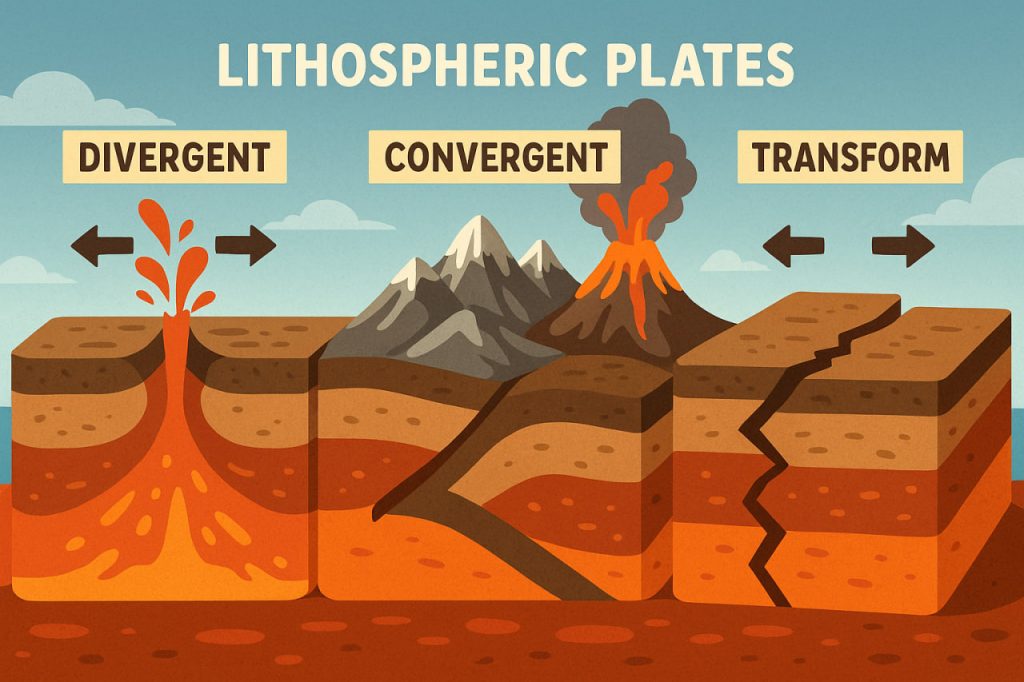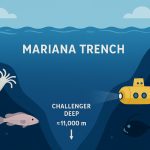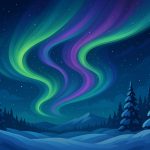The lithosphere is Earth’s rigid outer shell, consisting of the crust and the upper part of the mantle. It is broken into large pieces called tectonic plates, which constantly move on the softer, more fluid asthenosphere beneath them. The places where these plates meet are called plate boundaries, and they are some of the most geologically active regions on Earth.
Types of Plate Boundaries and Their Processes
- Divergent Boundaries (Plates Moving Apart)
- Found mostly along mid-ocean ridges.
- Magma rises from below the mantle, creating new oceanic crust.
- Example: the Mid-Atlantic Ridge, where the Eurasian and North American plates are moving apart.
- Results: formation of new seafloor, volcanic activity, shallow earthquakes.
- Convergent Boundaries (Plates Colliding)
- One plate may slide beneath another in a process called subduction.
- Oceanic plate + continental plate → subduction zones with deep trenches and volcanic arcs.
- Continental plate + continental plate → collision forms mountains (e.g., the Himalayas).
- Results: powerful earthquakes, volcanoes, and mountain building.
- Transform Boundaries (Plates Sliding Past Each Other)
- Plates grind horizontally against one another.
- No crust is created or destroyed.
- Example: San Andreas Fault in California.
- Results: strong earthquakes, surface displacement, cracks in Earth’s crust.
Why Plate Boundaries Matter
- Earthquakes – Most major earthquakes occur along plate boundaries due to the buildup and sudden release of stress.
- Volcanoes – About 75% of the world’s active volcanoes are located near convergent or divergent boundaries.
- Mountains and trenches – The tallest mountains and deepest ocean trenches are created at these boundaries.
- Geological evolution – Plate tectonics drive the continuous reshaping of Earth’s surface.
Life and Hazards at Plate Boundaries
- Many of the world’s largest cities (Tokyo, San Francisco, Mexico City) are located near plate boundaries, making them vulnerable to natural disasters.
- At the same time, volcanic soils near boundaries are fertile, supporting dense human populations.
- The constant recycling of crust through subduction and volcanism is crucial for Earth’s long-term climate and habitability.
Conclusion
The boundaries of lithospheric plates are zones of intense geological activity where new crust is formed, old crust is recycled, and Earth’s surface is reshaped. These regions are both sources of natural hazards and essential parts of the planet’s dynamic system. Understanding them helps humans prepare for earthquakes and volcanic eruptions while appreciating the forces that shape our world.
Glossary
- Lithosphere – Earth’s rigid outer shell, including the crust and upper mantle.
- Asthenosphere – the softer, partially molten layer beneath the lithosphere.
- Divergent boundary – where plates move apart and new crust forms.
- Convergent boundary – where plates collide, often causing subduction or mountain formation.
- Transform boundary – where plates slide horizontally past one another.


